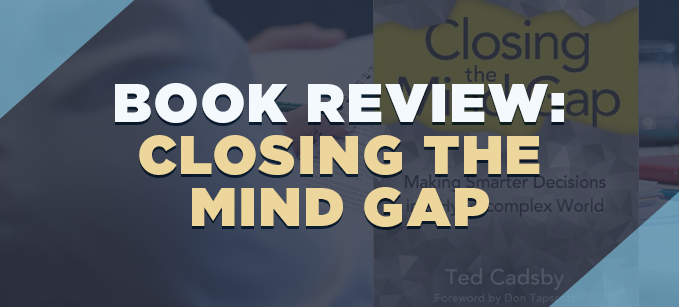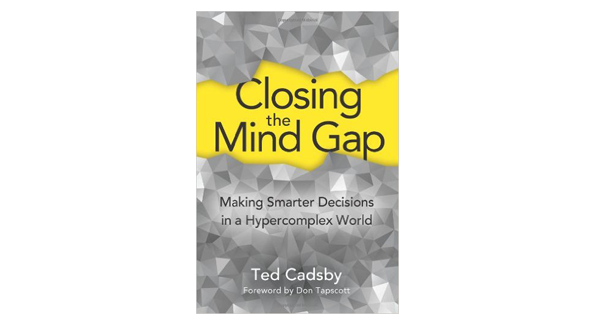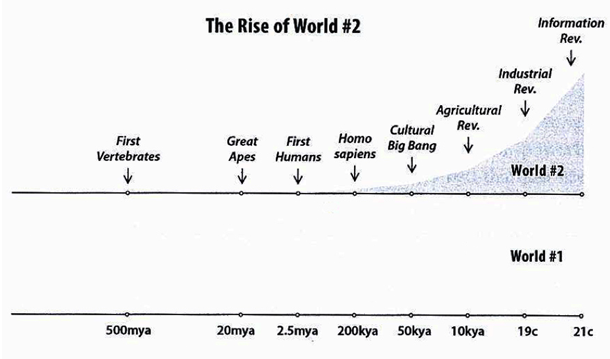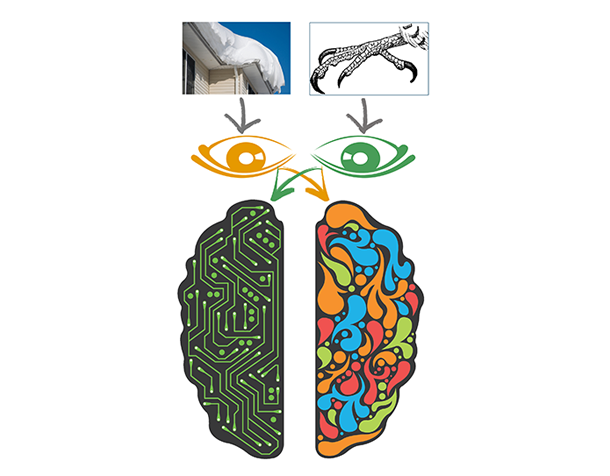Book Review: Closing the Mind Gap by Ted Cadsby

Closing the Mind Gap: Making Smarter Decisions in a Hypercomplex World is a GREAT book with two major flaws that must be addressed and dealt with before delving any further into its awesomeness. First, there’s the title: it’s kind of boring.
Second, and don’t freak out, but the book is about mental complexity.
It’s a topic likely to make people suspect the involvement of graphs, equations, technical mumbo, science mumbo, and math mumbo. (Okay, the book has graphs, but the general mumbo jumbo dial isn’t set too high.)

Title and topic aside, Closing the Mind Gap is a fascinating and illuminating journey into the giant mega-factory of stupidity and arrogance that is proudly produced by the human animal.
If you love anything to do with psychology, philosophy, learning, and behavioural economics, this is right up your alley. If you haven’t spent a lot of time on any of these topics, then even better, because the book summarises a large number of important concepts, researchers, and authors across these disciplines which is guaranteed to raise your IQ by 50 points.*
Here’s the central premise of the book: there are two basic mental landscapes that humankind has been forced to confront.

World #1 is the world that our distant ancestors thrived in—a simple world with straightforward relationships between cause and effect. (e.g., tiger = death = RUUUUN.)
World #2, which we are being forced to spend more time in, is the world of abstract complexity with non-linear relationships between cause and effect (e.g., how to create the best HR strategy for a 50,000+ multi-national giant).
Our brains have evolved to deal with World #1 and we’re unbelievably good at it. But we kinda suck at World #2. The book’s genius is showing us just how ill-equipped our brains are when it comes to anything remotely approaching complexity. As a result, you might never trust your intuition again.
10 Awesome (or Sort-of-Half-Decent-Good) Quotes
A small sample of the quotey goodness...
- We have not even scratched the surface of the myriad ways in which our thinking is bounded. Our memory is hopelessly inaccurate, our willpower is more like whim-power, our emotions are overreactions that reduce our reasonableness to that of an angry monkey, and we are hopelessly hypocritical yet aggressively self-righteous.
- There is no polite way to put it: we are not as smart as we think we are. We are irrational, illogical, innumerate, unreasonable and overreactive. But, as the following chapters reveal, our two biggest problems — the most prominent (and interesting) of our cognitive frailties — are oversimplification and overconfidence.
- Subconscious thinking precedes conscious thinking. The best-known experiments on the delay between subconscious and conscious thinking were conducted by psychologist Benjamin Libet. He clocked subjects’ awareness of their decision to act at around 350 milliseconds after a brain scan had registered that a decision had been made (the electrical activity, or “readiness potential,” showed up before the subject reported his decision).
- ... "either/or" enables us to effortlessly turn gray into black or white. Either the governing party is effective or it is incompetent. Either religion is beneficial or it is detrimental. Either a person is extroverted or introverted.
- ... a host of expressions are underused: "don't know"; "could be"; "perhaps"; "I need more information"; and "I'm not in a position to render judgment."
- Any attempt to understand complexity must start with the premise that there is always missing information. There is always more to the story... Systems theory is the best we have come up with so far to ferret out more of the story.
- The human mind is a story processor, not a logic processor... We start by selecting signals to pay attention to, searching for familiar patterns by using models to organise data into relationships. We end by creating stories about the modelled data. Where the key to selection is perceived relevance, and the key to modelling is pattern recognition, the key to storytelling is coherence: we create stories that cohere with everything we know, stories that make sense to us... we are desperate for stories.
- ‘Apophenia’ is the finding of patterns in meaningless data: the image of Mary in a slice of toast, a lucky streak in a card game, a bad-luck streak of three mishaps in a row, or a premonition that happens to come true.
- It makes for a good story (and a bestselling book) to say the key to success in business is ... insert magic formula here. But these stories are all highly suspect. Management consultant Michael Raynor and his coauthor point out that one book categorised Campbell Soup as a 'winner' based on its ten-year performance from 1986 to 1996, whereas a different book identified the company as a 'loser' based on its ten-year performance from 1992 to 2002.
- Scepticism is a leveller: while this does not put all beliefs in the same category, it does prevent beliefs about complexity from jumping to the elite status of certainty.
1 Awesome (or Sort-of-Half-Mind-Blowing) Example
One of the most interesting examples of the myriad ways in which our brains can create mischief is research done on people who have had the part of the brain that connects the two hemispheres (the corpus callosum) damaged or surgically removed.
In one experiment, the left eye of a participant was shown a picture of a house with its roof covered in snow.
And the right eye was shown a chicken claw.
Because, you know, chicken claws are awesome.

Now, here's the thing about brains: our left eye is routed through our right hemisphere (the one associated with creativity and holistic thinking).
Our right eye is routed through our left hemisphere (the one associated with language and logic).
Without the corpus callosum, the two hemispheres can't "talk" to each other, so the information that passes through the eye stays within that one hemisphere. This way, we can learn a lot about what each particular hemisphere does when given a particular task.
When asked to pick a drawing that related to the two images, the participant picked a snow shovel with his left hand, which makes sense since this corresponds to the right hemisphere. And then he picked a chicken claw with his right hand, corresponding to the left hemisphere. Makes sense. Nothing unusual so far.
However, when the participant was asked why he would need a snow shovel (a language/logic task that is performed by the left hemisphere) the participant told the researcher that he needed the shovel to clean out the chicken shed, failing to even acknowledge the existence of the snow!
As Cadsby explains...
"The key to understanding this odd response... is to appreciate that the right hemisphere (which saw snow) does not have a language capability or a strong sense of causality, so it is up to the left hemisphere to articulate the rationale for picking the shovel image after the fact. The left hemisphere has not seen the snow so it has to confabulate a reason for choosing the shovel: it makes up a story that has internal coherence, which is that the shovel goes with the chicken claw, to clean out the chicken coop. The left hemisphere refuses to be stumped, so it invents a satisfactory explanation."

For more woah moments, check out Closing the Mind Gap on Amazon.
In no way have we been paid for comment or asked to endorse this book... it's just a wicked head trip.
*Guarantees made to raise your IQ may or may not be totally made up on the spot.
Topics:
Smarter Thinking
Theo Winter
Client Services Manager, Writer & Researcher. Theo is one of the youngest professionals in the world to earn an accreditation in TTI Success Insight's suite of psychometric assessments. For more than a decade, he worked with hundreds of HR, L&D and OD professionals and consultants to improve engagement, performance and emotional intelligence of leaders and their teams. He authored the book "40 Must-Know Business Models for People Leaders."

/Workshop%2011%20-%20Enhancing%20Team%20Creativity%20Workshop.png?width=374&name=Workshop%2011%20-%20Enhancing%20Team%20Creativity%20Workshop.png)
/Revisiting%20a%20Business%20Classic_%20Good%20To%20Great.png?width=374&name=Revisiting%20a%20Business%20Classic_%20Good%20To%20Great.png)
We Would Like to Hear From You (0 Comments)